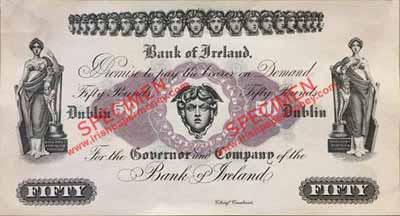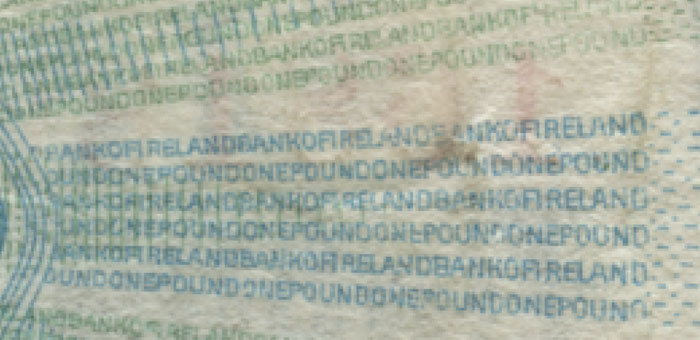The Bank of Ireland’s series of 1922 was arguably the first modern Irish banknote series. It was the first major change of the bank’s core banknote design since 1838, and the first time that banknotes of Bank of Ireland were printed on both sides. This series was also to be the last all Ireland issue of the bank. The development and initial issues of the new Series H resulted in several very rare banknotes early in the series.
Bank of Ireland series H was the end result of the modernisation of its note issues during the period of the transition of Irish currency, when all of the banks modified their note designs, moving to smaller size notes, and removing the listings of branches when they were no longer required to state the branch of payment on a note.
Series H design notes were in use until 1928, when the partition of Ireland in 1921 lead to the partition of the Irish currency in 1929 into a separate Currency Commission Irish Free State issue and a Northern Ireland Issue for each of the joint stock banks which issued notes. The Bank of Ireland made minor modifications to the Series H note note design by changing the head office to Belfast instead of Dublin on the notes for its Northern Ireland Issue.
Bank of Ireland Series H consisted of six denominations: £1, £5, £10, £20, £50, £100. Records indicate that all of these were printed for issue, though £20, £50, and £100 notes may never have been issued. Bank of Ireland Specimens exist of all the denominations




New design. Small sized modern banknotes printed on both sides. Head Office DUBLIN. Banknote sizes increase with denomination. £20, £50, £100 notes are of uniform size. Banknote sizes vary within a denomination by a few millimeters. All notes bear the water mark 'Bank of Ireland'.
There are two signature variations for Series H banknotes, giving two basic Types: A and B, defined by signature: S. Hinton (Type A, 1922-1923), and J. A. Gargan (Type B, 1923-1928). These two Types divide into four distinct variations of £1 notes and £5 notes, two for each Type; and three recorded distinct variations of £10 notes, as listed below.
Type A


Type B



Two Types by signature: Type A, signature: S. Hinton; Type B, signature: J. A. Gargan.
A1: initial printage, date in copperplate typeface.
A2, B1, B2: month in sans-serif typeface, with day and year in serif typeface.
Black serial numbers and dates on all Types except £1 notes of Type B2, where prefix and serial number are changed to red. Six digit serial numbers on all varieties. Prefix number serif, letter sans-serif on all varieties.
£1, £5, £10, £20, £50, £100.
£1 notes. Linear prefix. Non-abbreviated date APRIL in copperplate typeface. 1 Date. 10.4.22.
£5 notes. Signature: S. Hinton. Date in copperplate typeface. Old style (taken from Series G £1 notes) 5 digit serial number with fractional semi-serif prefix on left and suffix on right. 2 Dates seen. 27.2.22, 10.3.22.
£1 notes. Months of more than 4 letters abbreviated in sans-serif type with serif numerals. 5 Dates. 1922.
£5 notes. Linear prefix, number serif, letter sans-serif. 2 Dates seen. 15.3.22; 16.3.22.
£10 notes. Linear prefix, number serif, letter sans-serif. 1 Date. 10.1.23.
£20. SPECIMEN 31.2.22. Linear prefix P, plus six digit serial number. No issued notes known.
£1 notes. Linear prefix. One Pound added in centre of note. Proof without date. 1 Date. 19.3.24.
£5 notes. Linear prefix, number serif, letter sans-serif. 4 Dates. 1923-1924.
£10 notes. Linear prefix, number serif, letter sans-serif. 1 Date. 14.1.24.
£1 notes. Red serial numbers, Fractional prefix. 8 Dates. 1925-1928.
£5 notes. Fractional prefix, number copperplate typeface, letter sans-serif. 8 Dates. 1925-1928.
£10 notes. Fractional prefix, number and letter copperplate typeface. 1 Date. 10.10.25.
Dimensions
BH–1. £1 notes [1922-1928] Prefix starts anew at 10A. 150 x 85 mm approx.
BH–2. £5 notes [1922-1928] Prefix starts anew at R/10. 175 x 95 mm approx.
BH–3. £10 notes [1923-1925] Prefix U continues from Series G. 195 x 105 mm approx.
BH–4. £20 notes [1922] Specimen Prefix P only. 205 x 108 mm approx.
BH–5. £50 notes [1922] SPECIMEN No issued notes known. 205 x 108 mm approx.
BH–6. £100 notes [1922] SPECIMEN No issued notes known. 205 x 108 mm approx.
Almost all the dates have been recorded for Series H: £1 Notes, 14 dates; £5 Notes, 18 dates; £10 Notes, 3 dates. There are three £5 note dates that have not yet been recorded. It is likely that all of the other issued notes have been recorded. Examples of all the recorded dates for Series H can be viewed in the Bank of Ireland Series H date listing 1922-1928.
The first series of banknotes issued by Bank of Ireland in 1783 was printed in England. However, since mid-1784 Bank of Ireland had printed its own notes in Dublin [1. Hall 1949, p. 54] on paper supplied from manufacturers in England. With the introduction of Series H banknotes, for the first time, the place of printing was inscribed on the reverse of each banknote, 'PRINTED AT THE BANK OF IRELAND, DUBLIN', illustrated below.

A security feature introduced on the 1922 banknotes was microprinting radiating from the centre of the reverse of each note, the words BANKOFIRELAND and the denomination in words repeated in alternate lines. Illustrated below is a close up of the reverse of the One Pound note.

Enhanced images show the watermarks on the small size Bank of Ireland One Pound and Ten Pound notes. The One Pound watermark is composed of the text "BANK OF IRELAND" in two lines, and the number "ONE" on each side near the location of the serial numbers.

The Ten Pound watermark is composed of the text "BANK OF IRELAND" in in a curve on the top, and the text "TEN POUNDS" in in a curve on the bottom. A similar watermark to that on the Ten Pound note is on the Five Pound note and the higher denominations.

1. Hall, F.G., 'The Bank of Ireland 1783-1946', Hodges Figgis, Dublin, 1949.
2. Bank of ireland Archives, Dublin.